1110 Search Results for Core
May 8, 2016
by Carole Zangari -
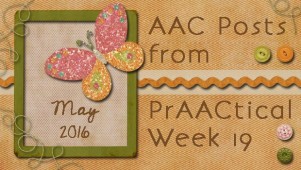
May is Better Hearing and Speech Month, a perfect time to build awareness among colleagues and in the community. Monday – PrAACtically May: Resources for a Year of Core Vocabulary Words Wednesday – Video of the Week: Increasing Core Vocabulary Use at Home, Therapy, and in School Thursday – AAC Assessment Corner with Vicki Clarke: The Eyes Have It – Assessment Considerations for High Tech Eye Gaze
May 1, 2016
by Carole Zangari -
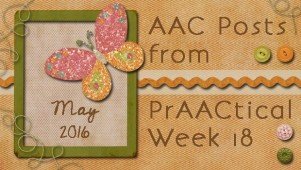
Here are some posts you may have missed. Tuesday: 5 Features to Look for in SGDs and AAC Apps Thursday: Video of the Week – Infusing Core Word Practice into Daily Interactions Friday: AAC Strategies Round-up: Aided Language Input
April 18, 2016
by Carole Zangari -
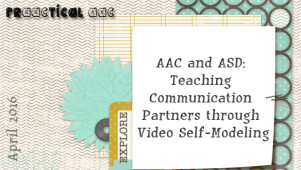
It is an honor to have Dr. Joanne Cafiero, an AAC consultant for individuals with complex communication needs and Autism Spectrum Disorders, as a guest contributor for today’s post. Dr. Cafiero is the author of Meaningful Exchanges for People with Autism an Introduction to AAC (2005). She is a consulting editor for Focus on Autism and Other Developmental Disabilities and has guest edited several of ASHA’s Perspectives in AAC. She was a member of the National Academy of Sciences Committee on Educational Interventions for Children with Autism (2001) and is currently working on an update on AAC and Autism for the Academy. In this post, she shares some of her work on video self-modeling. ::::::::::::::::::::::::::::::::::::::::::::::::: Growing research and first-person reports are illuminating the unique sensory and motor differences experienced by people on the Autism Spectrum. This new information has a huge impact on the AAC practitioner. Motor planning differences in ASD can... [Read More...]
April 10, 2016
by Carole Zangari -
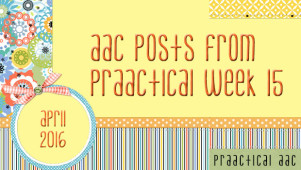
Had a busy week? Here are a few posts that you may have missed. Monday – PrAACtical Teaching in an ASD Classroom: Little Tips for Big Core Wednesday – Video of the Week: AAC at Home Thursday – Beyond Autism Awareness to Acceptance, Understanding and Inclusion
April 7, 2016
by Carole Zangari -
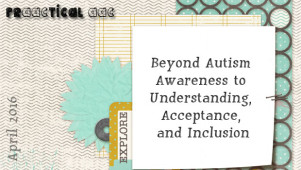
Given that PrAACtical AAC was co-founded by a master clinician with a deep love of autism, Dr. Robin Parker, it comes as no surprise that we’ve published well over 200 posts that focus on supporting children and adults with autism. Here are a few that relate specifically to going beyond awareness and build understanding, acceptance, and inclusion. Autism Awareness and Acceptance Month: 5 Videos for Kids 20 Ways for SLPs to Celebrate Autism Awareness and Acceptance Month 10 Things to do for Autism Awareness/Acceptance Month 30 Things to Do for Autism Awareness Month Keep Learning About Core: 8 More Things to Do for Autism Awareness and Acceptance Month Do you have meaningful ways to help others move beyond awareness? We’d love to hear about them.
April 3, 2016
by Carole Zangari -
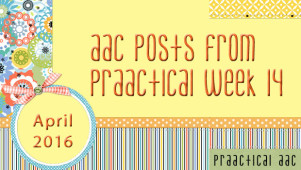
Hope you had a great start to Autism Awareness and Acceptance Month! Monday – PrAACtical Resources: Video Explainers for Aided Language Input Wednesday – Video of the Week: Getting Started with PODD Friday – PrAACtically April: Resources for a Year of Core Vocabulary Words
March 28, 2016
by Carole Zangari -
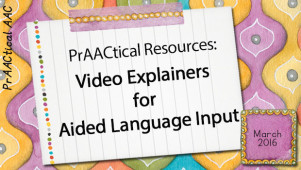
A growing number of clinicians, families, and educational teams are prioritizing the use of aided language input as a foundational strategy for AAC learners. When we first started writing about this strategy, it was rare to see adults using AAC to talk with AAC learners.Consistent implementation is still a challenge, but more and more of you are speaking AAC to teach AAC. And quite of few of you are doing your best to influence other stakeholders to support augmented communicators in this way. If you are doing inservices, teaching classes, or guiding teams toward better AAC intervention, the videos listed below may be useful to you in those efforts. Chris Bugaj developed this clear and engaging cartoon explaining the concept for people new to this strategy. Caroline Musselwhite recorded a full webinar with detailed information on aided language input. Communicare, a clinical practice with a strong focus on AAC,... [Read More...]
March 24, 2016
by Carole Zangari -
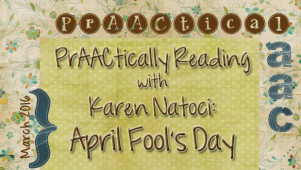
It’s gratifying to hear from so many of you who are including storybook reading in your AAC instruction and therapy. We welcome back Karen Natoci, Assistant Professor and SLP Oregon Health and Science University’s Child Development Rehabilitation Center. She serves on the Neurodevelopment and Rett Evaluation teams and has a caseload of children with Complex Communication Needs and AAC. Karen tells us that “I know very well the feeling of being overwhelmed by the high needs of students with complex communication needs and will readily admit that you have to have a very large ‘toolbox’ of ideas!” Currently, she is on the charter development team to create the Communication Matrix- Virtual Community of Practice with Charity Rowland. At the end of the day, Karen enjoys running, practicing piano, and exploring Portland and the Oregon coast. :::::::::::::::::::::::::::::::::::::::::::::::::::::::::::::::::::::::::::::::::::::::::::::::::: Book: April Fool’s Day Written and Illustrated by Dee Smith (Also available from Deesignery.com) Core Vocabulary focus: Look,... [Read More...]
March 20, 2016
by Carole Zangari -
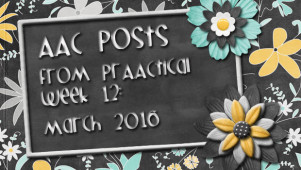
Hope your prAACtical week was productive and satisfying. Monday – PrAACtical Teaching in the ASD Classroom: Bigger is Better with Core Vocabulary Wednesday – Video of the Week: Building Linguistic Fluency with AAC Learners Thursday – AAC Assessment Corner with Vicki Clarke: Is Feature Matching Still Relevant?
March 17, 2016
by Carole Zangari -
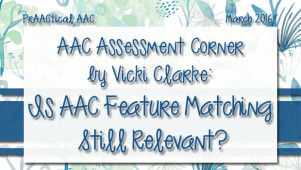
Today, we welcome back Vicki Clarke, a regular contributor to PrAACtical AAC, with another edition of AAC Assessment Corner. In this post, Vicki shares her thoughts on feature matching for AAC device selection. ::::::::::::::::::::::::::::::::::::::::::::::::::::::::::::::::::::::::::::::::::::::::::::::::::::::::::::::::::::: Feature matching has been the gold standard for AAC evaluation for the last 20 years. It is research based and clinically proven as the best technique for selecting an AAC solution for an individual. The tide of real-life practice, however, is turning and there has been increasing discussion at conferences, in social media and blogs questioning why we continue to use feature matching to place AAC systems in the hands of students. In a recent assistive technology on-line chat, a noted AT specialist remarked: “I wonder if at a district level it might not be better to have a go-to AAC system everyone tries first. If that doesn’t work then adjust.” Does this mean that we throw... [Read More...]









